Overview
Convertible notes and SAFE notes represent distinct funding instruments that cater to the diverse preferences of investors and the unique needs of startups. Convertible notes, with their structured debt-like features, provide a sense of security through interest and maturity dates, which can be comforting for those seeking stability. On the other hand, SAFEs offer simplicity and flexibility, increasingly resonating with startups aiming for easier capital raising methods as we approach 2025.
We understand that many of our members might feel overwhelmed by these choices. The trend towards SAFEs reflects a significant shift, as they allow for a more straightforward approach without the burden of interest and deadlines. This shift highlights a growing desire among startups for accessible funding solutions, ensuring they can focus on their mission and growth.
As we navigate these options together, it’s essential to consider what aligns best with your goals and comfort level, fostering a supportive community where we can share experiences and insights.
Introduction
In the ever-changing world of startup financing, we recognize that navigating the options of convertible notes and SAFE notes can feel overwhelming. These instruments have become essential tools for securing capital, yet understanding the nuances between them is crucial for both investors and entrepreneurs alike.
Convertible notes, with their structured approach and defined terms, often attract those who are cautious about risk, while SAFE notes offer a more flexible and straightforward pathway for startups, mirroring a growing trend in the tech sector.
As many of our members have experienced, the shift towards SAFEs—especially among early-stage companies—has profound implications for investment strategies.
This article aims to explore the mechanics, advantages, and market trends surrounding these funding instruments, providing you with the insights necessary to confidently navigate the complexities of today’s funding landscape.
We understand that these choices can be daunting, but together, we can foster a supportive community that empowers you on your investment journey.
Name: Defining Convertible Notes and SAFE Notes
Convertible securities serve as short-term debt instruments that transition into equity during future financing rounds, making them an appealing option for startups in search of initial capital. These instruments often come with specific terms, such as interest rates and maturity dates, which can significantly influence an overall financial strategy. On the other hand, Simple Agreements for Future Equity (SAFEs) present a more straightforward alternative, allowing investors to convert their investment into equity at a later date without the complexities of accruing interest or adhering to a maturity timeline.
This fundamental difference lays the groundwork for a deeper exploration of their mechanics and implications for investors, particularly in the context of convertible notes versus SAFEs.
As we approach 2025, the landscape for convertible instruments and simple agreements has transformed remarkably. Recent statistics indicate that approximately 60% of startups now prefer SAFEs over convertible instruments, reflecting a growing inclination towards the simplicity and flexibility these agreements offer. This trend is especially pronounced in the tech sector, where agility and speed are crucial.
Moreover, the increasing connection between startups and venture capital firms to present innovative ideas and unlock business potential highlights the significance of these funding instruments within the broader investment landscape. We understand that navigating these options can be daunting, and expert opinions shed light on this evolving trend. Venture capitalists note that while convertible instruments provide a structured approach to early-stage funding, the discussion surrounding convertible notes versus SAFEs reveals that the absence of interest and maturity dates in SAFEs often makes them more appealing to founders. For instance, Jim Marshall, Head of SVB’s emerging manager practice, points out that founders are becoming increasingly cautious about diluting their equity too early, aligning with the model's design to minimize immediate ownership stakes.
Real-world examples further illustrate these dynamics. For instance, Fracttal successfully raised $7.44 million through four funding rounds utilizing convertible instruments, showcasing how this mechanism can facilitate significant capital influx without the constraints of traditional debt. Additionally, WNT Ventures actively invests in deep tech founders, providing hands-on assistance and resources while favoring convertible securities for their adaptability in pre-revenue stages.
Their commitment to supporting pre-revenue tech firms underscores the practical benefits of utilizing SAFE agreements in fostering growth and innovation.
In conclusion, understanding the distinctions between convertible notes and SAFEs is essential for tech investors navigating the startup funding landscape in 2025. The choice between these tools can have a profound impact on financial outcomes, making it vital for individuals to stay informed about current trends and expert insights. We are here to support you in this journey, ensuring you feel empowered and connected as you explore your investment options.
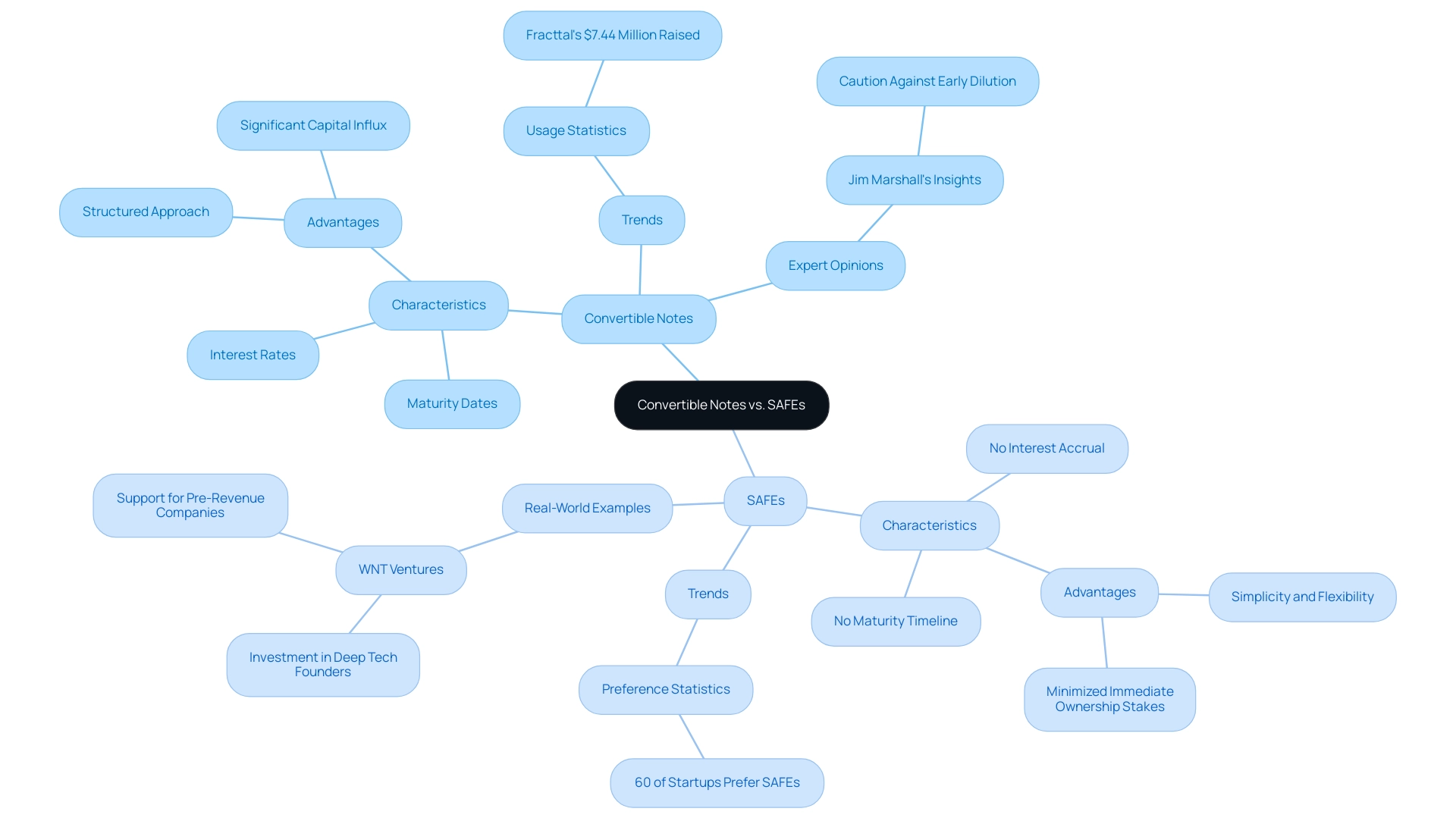
Key Terms and Mechanics of Convertible Notes
Convertible notes have emerged as a vital financing instrument in the tech investment landscape, especially in 2025. However, understanding the essential terms associated with these notes is crucial for investors navigating this space:
- Principal Amount: This represents the initial investment made by the investor, forming the foundation for future returns.
- Interest Rate: Typically, convertible instruments carry an interest rate that accrues over time, often payable upon conversion to equity. In 2025, average interest rates on convertible instruments are projected to hover around 6-8%. This competitive nature of the market is something our Finance, Freedom, Fellows (fff.club) community members should be aware of, as it can significantly influence their investment strategies and foster informed decision-making.
- Maturity Date: This is the deadline by which the instrument must either convert into equity or be repaid. Standard maturity dates for convertible bonds in 2025 range from 12 to 24 months, offering a clear timeline for stakeholders.
- Conversion Terms: These terms dictate how and when the instrument converts into equity. Commonly, they include a discount rate or a valuation cap, serving as protective measures for those providing capital. For instance, a discount rate of 20% enables stakeholders to transform their securities into equity at a lower price relative to subsequent funding rounds, thereby increasing their potential gains.
Understanding these mechanics is essential for tech investors. As many of our members have experienced, the dynamics between convertible notes and SAFE agreements indicate that the convertible debt market is projected to grow at a compound annual growth rate (CAGR) of 10% from 2020 to 2025. This growth highlights the increasing reliance on convertible notes as a viable financing option.
In practice, case studies from the fff.club community illustrate the significance of these terms. Members have effectively maneuvered through the intricacies of convertible agreements, utilizing their knowledge of essential terms to enhance their financial strategies. For example, one member who utilized a valuation cap effectively secured equity at a favorable valuation during a subsequent funding round, significantly boosting their returns.
Mihkel Torim from LHV emphasizes, "The club's commitment to equipping members with the necessary insights and resources to make informed decisions"—a testament to the value of being part of such a nurturing community.
As the market evolves, financial analysts stress the importance of being well-versed in these key terms. We understand that a thorough grasp of convertible notes mechanics not only aids in making informed financial decisions but also fosters a deeper understanding of wealth management in the tech sector. This holistic approach is vital for participants aiming to thrive in the dynamic landscape of private market investments, particularly within the supportive framework of the fff.club community.
Akim Arhipov and Tim Vaino, the creators of fff.club, believe that financial superpowers should belong to everyone. They are dedicated to providing inclusive financial education and resources to empower technology enthusiasts, ensuring that all members feel valued and equipped to navigate their investment journeys.
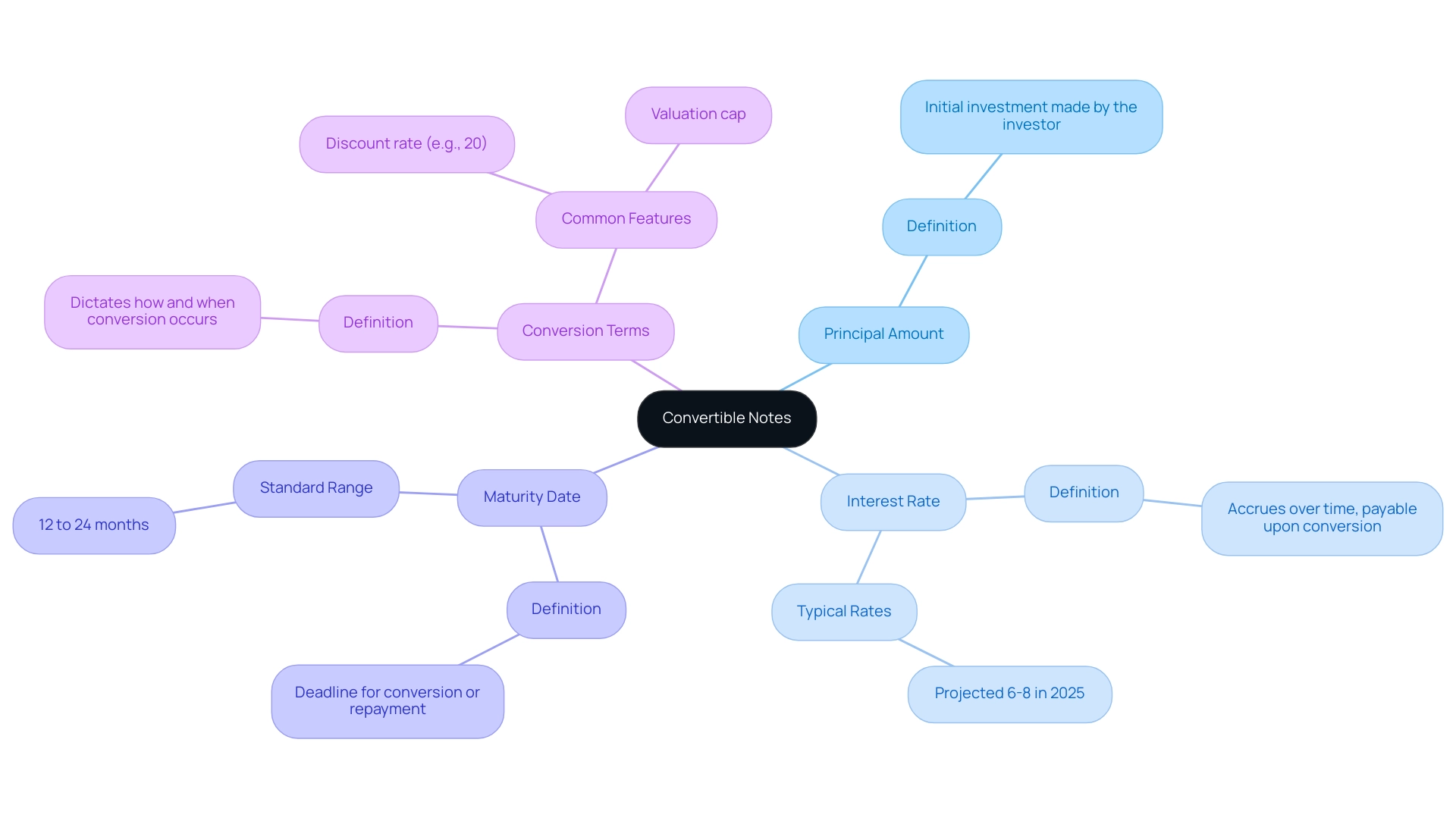
Understanding the Structure and Terms of SAFE Notes
These agreements are structured in a way that sets them apart from convertible agreements, offering several essential characteristics that make them especially appealing for both startups and their backers:
- No Interest: Unlike convertible agreements, these agreements do not accumulate interest. This absence of interest alleviates financial pressure on startups, allowing them to focus on growth without the burden of accumulating debt. We understand that financial stress can hinder progress, and this feature provides a breath of fresh air for many entrepreneurs.
- No Maturity Date: SAFEs lack a fixed conversion date, which provides flexibility for both backers and startups. This feature enables startups to manage their funding rounds without the pressure of looming deadlines, fostering a more favorable atmosphere for growth. Many of our members have shared how this flexibility has allowed them to concentrate on what truly matters—their vision and innovation.
- Valuation Cap and Discount Rate: These agreements often include a valuation cap, setting a maximum price at which the capital can convert into equity. Additionally, a discount rate allows investors to convert their investment at a lower price compared to future investors. These characteristics enhance the appeal of simple agreements for future equity in early-stage financing, aligning the interests of both parties while reducing risks. As we’ve seen in our community, this alignment can lead to stronger partnerships and successful outcomes.
In 2025, a significant percentage of such agreements incorporate these features, with many startups leveraging valuation caps and discount rates to secure advantageous terms. For instance, WNT Ventures, which invests in pre-revenue tech companies, exemplifies the effective use of convertible instruments by providing hands-on support and resources tailored to deep tech founders. This method not only facilitates capital influx but also equips startups with the essential resources to build robust intellectual property.
As highlighted by Taavi Rõivas, former Prime Minister of Estonia, the funding environment is evolving, and instruments like convertible securities are crucial for fostering innovation and supporting startups. Specialist views underscore the benefits of these instruments in today’s funding landscape. As articulated by industry leaders, including members of the Finance, Freedom, Fellows community, these instruments offer a streamlined path for startups to access capital while maintaining investor interest through favorable conversion terms.
Real-life instances further illustrate the advantages of these agreements, showcasing how they enable startups to attract investment without the complexities associated with traditional instruments like convertible notes versus SAFEs. Overall, the framework and conditions of convertible securities in 2025 reflect a growing trend towards more adaptable and investor-friendly funding methods, with many startups recognizing the importance of community involvement and education in navigating these opportunities. The Finance, Freedom, Fellows community, with over 400 engaged tech financiers, plays a pivotal role in this ecosystem, providing collaborative wealth management and educational resources that empower tech stakeholders. We believe that together, we can create a supportive environment where innovation thrives.
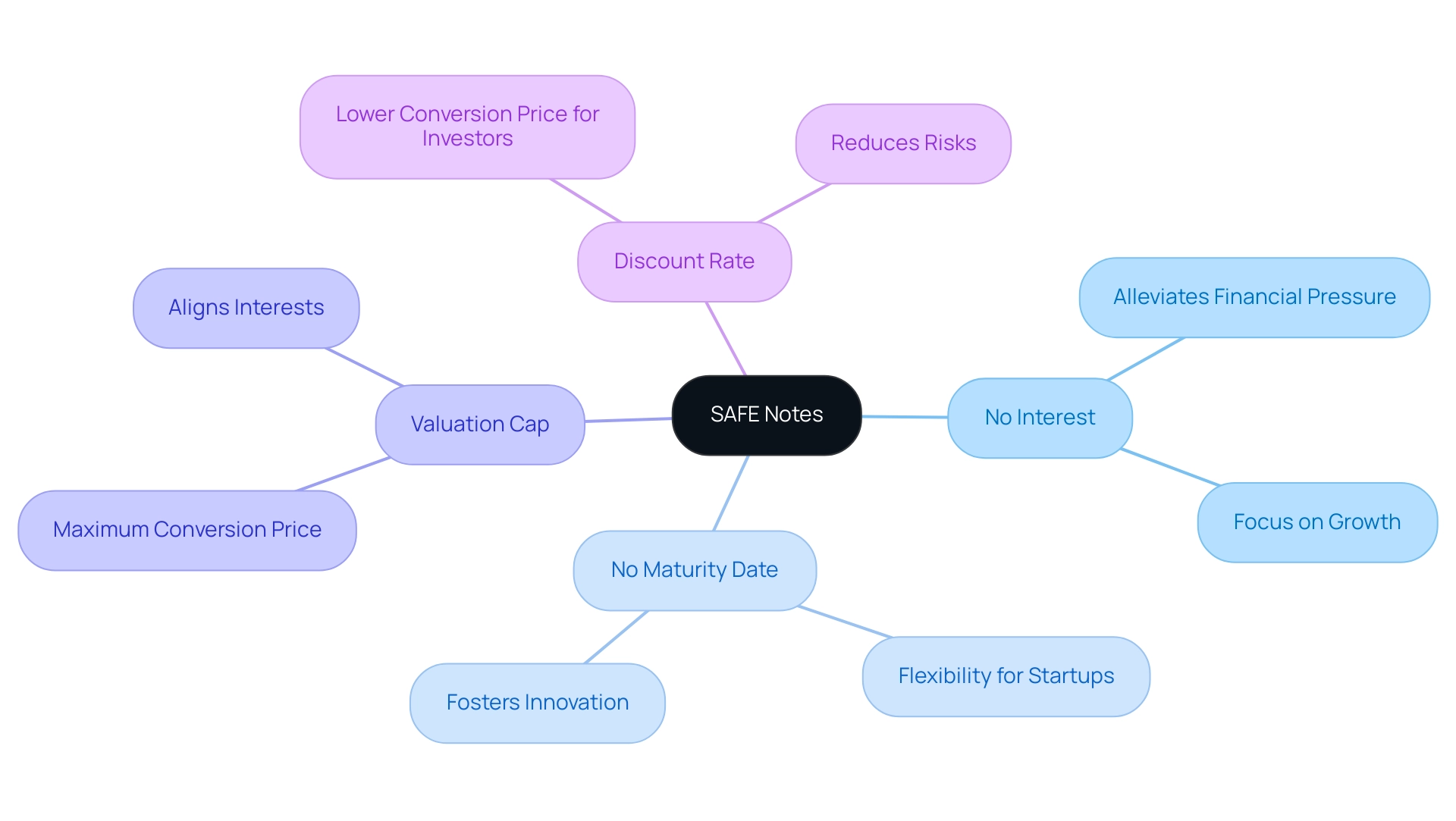
Investor Perspectives: Choosing Between Convertible Notes and SAFE Notes
When navigating the decision between convertible notes and SAFEs, it’s essential to consider your risk tolerance and financial aspirations. We understand that making these choices can feel overwhelming, and it’s important to find a path that aligns with your goals.
Convertible Notes: These instruments often attract those who are cautious about risk, as they carry debt-like features, including interest payments and a defined maturity date. This structure not only provides a potential return on your investment but also offers a clearer route to equity conversion. For many, this transparency can be a comforting factor amidst the uncertainties of a startup's future. In fact, if a startup encounters difficulties before a triggering event, holders of convertible instruments may reclaim their investment as creditors, providing an additional layer of security.
As David Lehrer, CEO, wisely notes, "As part of the pros and cons of convertible note agreements, their speed and efficiency can be a great advantage, particularly at a company’s earliest stages."
SAFE Notes: On the other hand, SAFE notes are often preferred by those seeking simplicity and flexibility. The absence of interest payments and maturity dates can relieve some of the burdens for startups, leading to quicker funding rounds. However, for individuals who prioritize immediate returns, this lack of short-term gains might be a concern.
Ultimately, the choice between a convertible note and a SAFE hinges on your unique investment strategy and the specific circumstances of the startup you’re considering.
In 2025, we see that financial backer preferences are increasingly shaped by these considerations, with many weighing the benefits of faster funding against the stability offered by convertible instruments. For instance, a recent case study titled 'Funding Requirements and Allocation' highlighted how a startup's transparent funding plan reassured backers about the strategic allocation of their capital. This underscores the importance of clear communication in the decision-making process.
Moreover, financial advisors stress the importance of understanding your risk tolerance when choosing between a convertible note and a SAFE. Statistics show a growing number of individuals are leaning towards convertible instruments, particularly due to their perceived security, while others still value the flexibility that SAFEs offer. As the investment landscape evolves, the insights gained from real-world experiences of navigating these choices will continue to guide best practices within our technology investment community.
This aligns with our mission to foster community engagement and education, ensuring that all stakeholders feel informed and supported in their decision-making journeys.
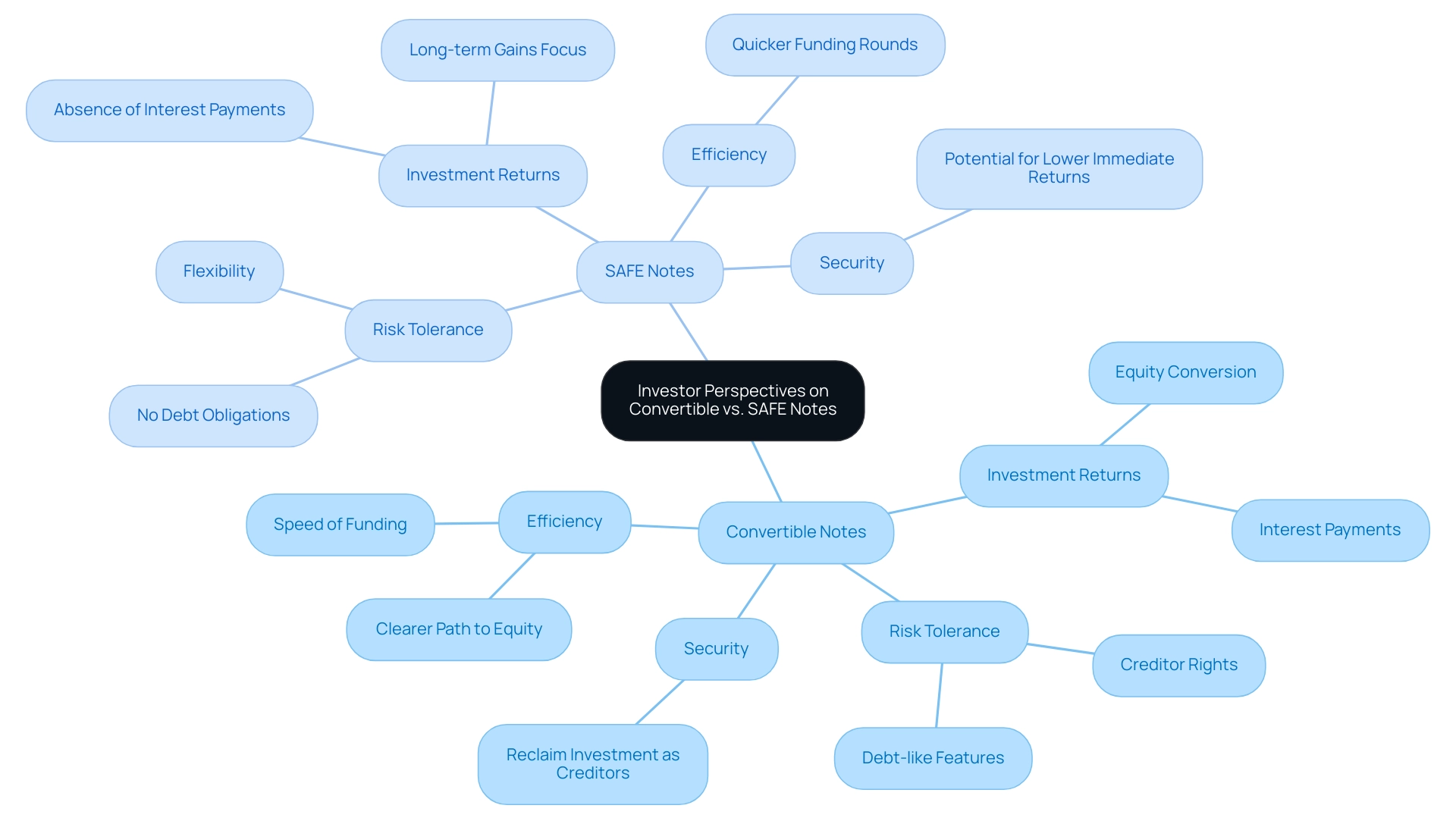
Market Trends and Future Outlook for Convertible and SAFE Notes
As we approach 2025, the landscape surrounding convertible notes versus SAFE agreements is undergoing significant transformation, particularly within the vibrant community of technology backers at Finance, Freedom, Fellows (fff.club).
- Convertible Notes: These instruments continue to draw in investors who value security and structured returns. Yet, the increasing complexity of their terms and conditions may lead many to seek more straightforward financing options. We understand that investors are prioritizing clarity and efficiency, which could reshape the appeal of convertible notes in the future. Within the fff. Club community, members actively engage in discussions that deepen their understanding of these complexities, fostering connections that empower informed investment decisions. Furthermore, opportunities for deal flow and co-investing are enthusiastically explored among members, creating a collaborative environment for tech investors.
- SECURE Agreements: The rise of SECURE agreements has been notable, especially among early-stage startups. Their simplicity and flexibility make them an appealing choice for quickly raising capital. Adam Watters, a Legal Intern at Sprintlaw, shares, "Utilizing a Simple Agreement for Future Equity is a straightforward yet powerful approach for small businesses and startups to secure the funding they require." Market trends indicate that discussions surrounding convertible notes versus SAFEs are becoming increasingly relevant as SAFEs emerge as the preferred financing instrument in the tech sector, where rapid execution is vital. Case studies reveal that startups utilizing convertible securities benefit from an efficient fundraising process, conserving both time and resources, which enhances their ability to focus on growth. This is especially pertinent in the realm of pre-seed funding, which is crucial for transforming ideas into successful startups. The insights exchanged among the 410+ tech professionals at fff. Club further empower members to effectively leverage these financing options. Additionally, members receive weekly tech and economic updates, keeping them informed about market trends and capital opportunities.
Looking ahead, it is likely that both convertible notes and SAFEs will coexist within the funding ecosystem. The preferences of financiers will significantly influence their application across various funding scenarios. As the market evolves, grasping the distinct advantages and uses of each instrument, particularly the comparison between convertible notes and SAFEs, will be essential for tech investors navigating the intricacies of private market investments.
With the unwavering support of the fff. Club community, members are well-prepared to adapt their strategies and seize emerging opportunities within the tech landscape.
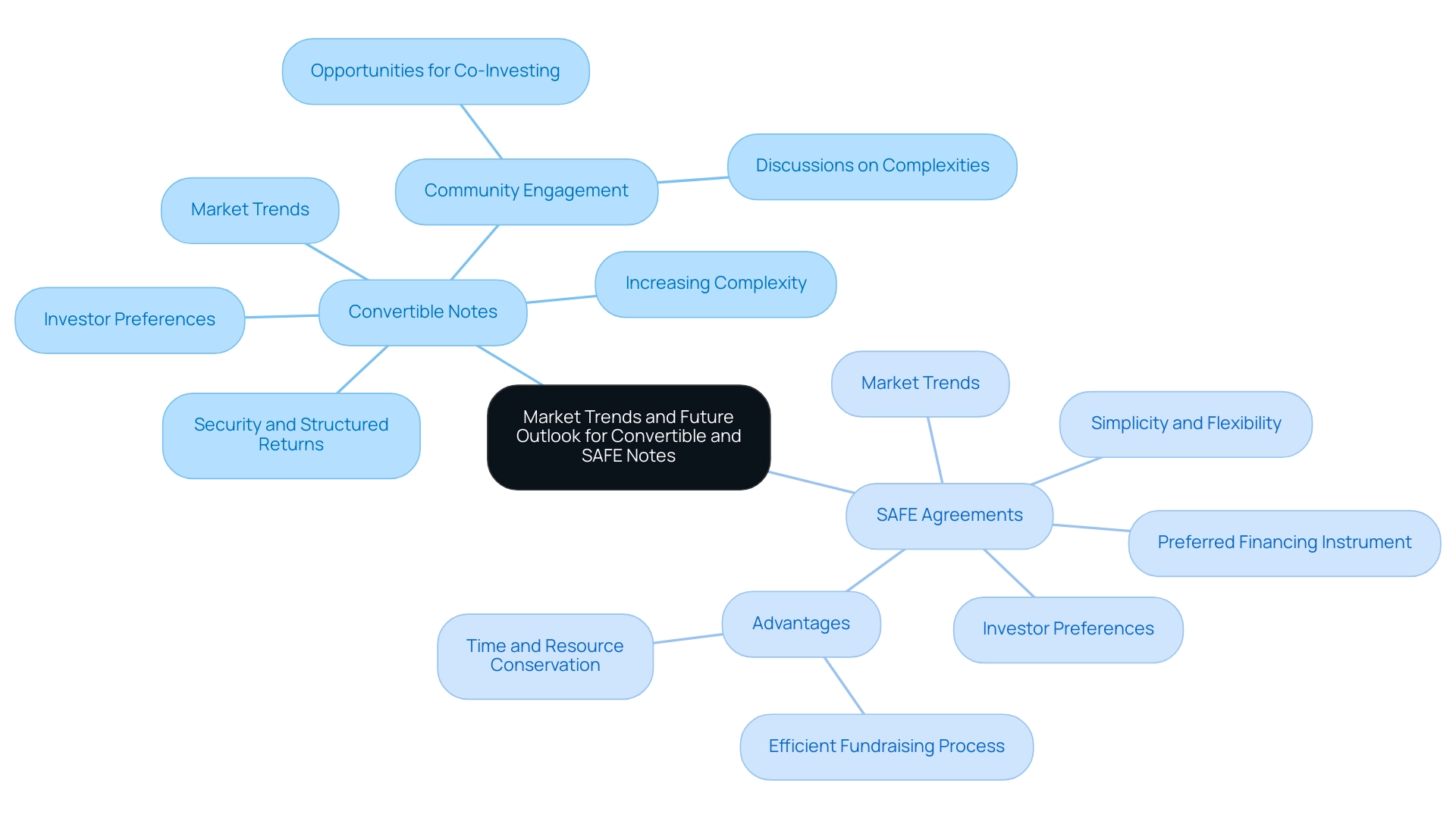
Conclusion
Navigating the startup financing landscape can be daunting for both investors and entrepreneurs. The exploration of convertible notes and SAFE notes sheds light on critical insights that can help ease this journey. Convertible notes offer a structured approach with defined terms like interest rates and maturity dates, which can be reassuring for those who prioritize security and potential returns. On the other hand, SAFE notes present a more flexible and straightforward funding mechanism, increasingly embraced by early-stage startups for their simplicity and absence of accruing interest or maturity deadlines.
As many of our members have experienced, there has been a significant shift towards SAFE notes, especially within the tech sector, where speed and agility are crucial. This trend highlights the importance of understanding the implications for investment strategies and risk management. Investors must carefully weigh their risk tolerance against the unique characteristics of each funding option, as the choice between convertible notes and SAFE notes can profoundly impact investment outcomes.
Looking ahead, both instruments are expected to coexist in the evolving investment ecosystem. The insights gained from market trends and real-world examples will continue to shape best practices within our tech investment community. By fostering a collaborative environment, resources like the Finance, Freedom, Fellows community empower investors to make informed decisions, adapting their strategies to thrive in this dynamic landscape. We understand that grasping the nuances of these funding mechanisms is essential for anyone looking to capitalize on the opportunities presented by the ever-changing world of startup financing.



